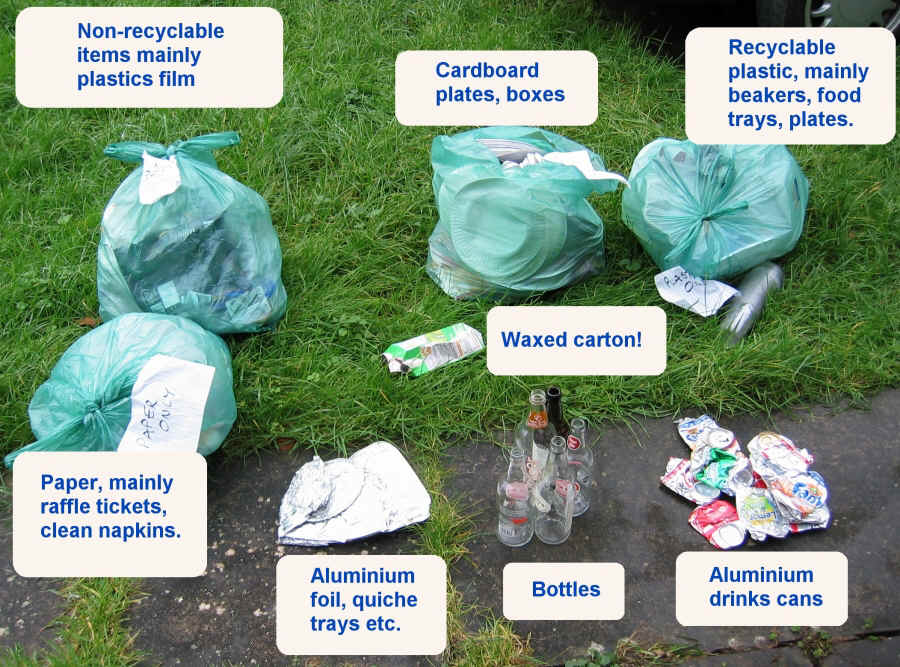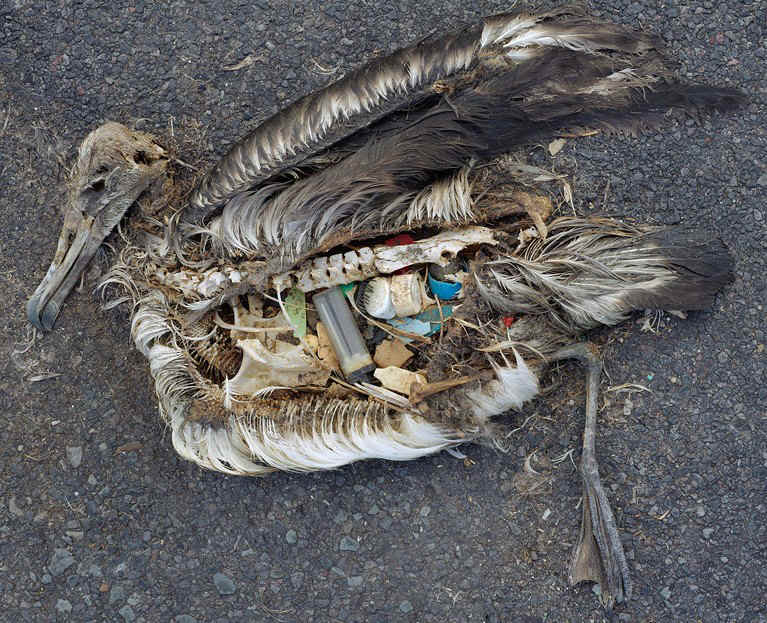Gittisham Folk Dance Club:
Recycling of waste from a Saturday night 'bring and share' meal for 110 people - and some
environmental links showing how plastics waste is destroying the world.
At most social dance and ceilidh events, no-one bothers to recycle waste. At my
instigation, Gittisham Folk Dance Club now implements recycling at its occasional Saturday
dance events, if only to try to set a good (albeit wholly trivial) example. I take home,
clean and check the pre-sorted waste before recycling it.
The total mass of waste brought home for final sorting from a dance in January 2016 was
6540g (6.54kg). The crude recycle rate based only on mass (which is often how local
councils in the UK assess their rates) was therefore 6.19/6.54 = 95%. The landfill waste
of 0.35kg comprised 5.4% of the total. If the glass bottles are excluded (they could
easily have been taken home by whoever brought them) the landfill component rises to 7.4%.
Looking to the future it should easily be possible to run
folk dances without using or offering plastics disposable products. Many people bring
plates of sandwiches and take their plates home - there is no waste apart from a little
Clingfilm. Too many people bring 'convenience' foods such a cheap Swiss rolls - these are
inevitably left largely uneaten and then thrown away. The aim should be to buy or prepare
foods that utilise a minimum of packaging. I usually take a bunch of free-range bananas.
Way back in 2004 I wrote an article on recycling for a
local environmental group - you can read it here. An earlier
article, from 2002, discusses sustainability.
Another, from 2008, argues that climate change is
unlikely to be addressed adequately. Little has changed! People are recycling more but
total resource usage continues to increase.
The first item in the list below is cardboard - and most of
the 2.2kg mass comprised large thick cardboard plates of a size and rigidity arguably
unnecessary for such an event. At Willand
Dance club for example, and elsewhere, smaller and lighter weight plates are used
routinely for 'bring and share' evenings - and are perfectly adequate. The plates used at
this Gittisham evening would have been more suitable for an event that included a large
formal meal.
Quite apart from being a waste in itself, buying such
expensive plates is a waste of club money - I'm allowed to say that because I was the
treasurer of Gittisham Club for 5 years. Under my guidance (some would say mild
parsimony), the club ended up with a balance of around £750.
 |
The masses of various material recycled were: Cardboard
2200g - mainly comprising thick cardboard plates
Glass bottles 1800g
Recyclable plastic 1500g - mainly plastics food trays and tumblers
Landfill waste 350g - mainly heavily soiled paper plates and non-recyclable plastic
film
Paper 260g - mainly raffle tickets and clean napkins
Aluminium cans 240g - several of these are marked No sugar. No calories. So why not
drink water?
Aluminium foil - 150g mainly quiche trays and the like
One waxed carton - 40g (custard)
The waste per person averaged 60g. |
At the dance in January 2016 some people took their own used drinks bottles etc home,
so what is itemised above is probably 80 to 90% of the total waste produced by one bring
and share meal for 110 people. A small quantity of food waste is not shown.
Inevitably, in a busy kitchen area with many people adding waste to various sacks some
items get misallocated. Ideally therefore, it all has to be resorted - a job that took me
about half an hour.
Is recycling worth the
effort?
 |
In terms of value of the items recycled, only
the aluminium would be saleable locally. 390g would be worth about 15p at 2016 prices,
down from 30p in 2003 before commodity prices slumped as a part of the 2015/6 downturn. Aluminium
is a very abundant element in the Earth's crust but it is worth recycling because of the
energy saving compared with extraction from bauxite. Scrap aluminium dumped on land or at
sea poses no great risk to the environment.
In monetary terms, none of the effort of domestic recycling is at all worthwhile, which
is why most people can't be bothered, which in turn is a prime reason why the Earth is now
so irreversibly polluted with waste plastics. It is a massive pollution problem without a
solution.
This widely viewed image is from this set.
A film about plastic pollution on Midway Island,
thousands of miles from any mainland. |
Saying that recycling is not profitable ignores what economists call externalities -
these include the value of damage not caused to the environment and the long term benefit
of using less virgin raw material for manufacturing new products.
If you set a value on 'keeping the Earth habitable' at infinity, then most or all
recycling becomes worthwhile so long as the acts involved in recycling (water for washing,
fuel for transportation) do not outweigh the benefits. Any encouragement to recycling or
acting more responsibly, is maybe a good thing, but recognising that it is now too late to
make much difference.
Recycling remains by far the least important of the 3Rs reduce, reuse, recycle that
have been an environmental mantra for over 40 years. To these, one more has been added ;
Refuse. Refuse to buy or use products made of plastic. And run folk dances without using
or offering plastics disposable products. In terms of environmental impact, the waste that
it is generally most worthwhile to collect and recycle properly is plastics because if
this gets into the marine environment (which much carelessly discarded plastics eventually
does) then it can cause catastrophic damage to wildlife. The problems on Midway Island
(see above) are one well documented example.
All changes in behaviour and/or outlook to help the Earth survive will result either
from the big decisions (made by governments sometimes under direct pressure from voters)
or from the trillions of small decisions billions of people make every year of their
lives. Both are important. Occasional small events (such as this dance) are far less
important than are everyday decisions - but attitudinal change can still be effected.
Transport energy.
The primary environmental impact of a dance is probably transport energy. Over 100
people in maybe 50 cars attended. If each car travelled a total distance of 40 miles about
220 litres of fuel would be used, the mass of which would be around 160kg. Plastic is (put
very simply!) hydrocarbons with some halogens added so the 1.5kg of plastic waste recycled
is (very roughly!) equivalent to 1% of the transport fuel used. But it takes energy to
recycle plastics, as well as energy to transport it to a recycling plant, so 0.1% might be
a more realistic answer.
To achieve a significantly more environmentally friendly dance, people would need to
use bicycles. Car sharing is one useful route to reducing fuel use. If people switched off
their house heating when they went to a dance, any saving could be offset against
transport energy. Buildings use large quantities of energy but it is not taxed to the same
extent as road fuel - so people don't think it's a priority for conservation efforts.
The future.
In the USA as elsewhere, forward thinking people are aiming for a zero waste lifestyle.
Many examples of the impact of plastics in the oceans can be found on TED.com. In
particular I'd recommend the talk by veteran oceanographer Sylvia Earle and by Capt.
Charles Moore. Since these talks were produced scientists have become even more concerned
that most life in the oceans may soon be extinguished.
I often recommend TED.com to people. It is a window to a world of intellect. Some links
are given below.
For talks about recycling put 'trash' in the search bar (it's American for rubbish!).
Or try 'hackers' for talks showing the abilities of computer hackers, one of whom is a
lead scientist in a group creating a system to kill mosquitoes using lasers.
The system is described here
http://www.intellectualventureslab.com/work/photonic-fence (an
incredible science lab part funded by Bill Gates of Microsoft)
The TED talk that led me to this website is here:
http://tedxtalks.ted.com/video/Top-Hacker-Shows-Us-How-Its-Don
(so you think your data or your house is safe?)
and the laser talk is here:
http://www.ted.com/talks/nathan_myhrvold_could_this_laser_zap_malaria
TED talks on plastics, pollution and ocean degradation include the following.
http://www.ted.com/talks/sylvia_earle_s_ted_prize_wish_to_protect_our_oceans
(recommended viewing)
http://www.ted.com/talks/capt_charles_moore_on_the_seas_of_plastic
(recommended viewing)
http://www.ted.com/talks/dianna_cohen_tough_truths_about_plastic_pollution
http://www.ted.com/talks/chris_jordan_pictures_some_shocking_stats#t-7393
(see also albatross picture links above)
http://www.ted.com/talks/van_jones_the_economic_injustice_of_plastic
http://tedxteen.com/talks/tedxteen-2015-nyc/295-lauren-singer-why-i-live-a-zero-waste-life
Gittisham Folk Dance Club page
Top of Folk Dance Section
Home page

